Hayward perseveres in the search for Truth. His determination and dedication for this quest is something to greatly admire. It is a privilege to be able to share part of his journey and thoughts here. Please feel free to leave comments or questions for him below.
This article will cover the geometry I found in connection with Davinci, the small Dagobert parchment from Rennes le Chateau and the book Maranatha Et in Arcadia Ego
Soon after I picked up a copy of Maranatha in 2010 (and I’m not really sure how I was initially lead to it), I had discovered a tilted hexagram on the second image in the book. It was probably because it seemed that the staffs in that image were quite obviously framing the outline of a particular visual shape on their own. When holding this page up to the light, and with the transparent image showing through the page on the other side, it seemed to become even more clear to me. I used the staffs as lines and extended them to try to draw a shape. The result seemed probable, but too irregular. I put the hexagram to the side and forgot about it for awhile.
It wasn’t until later, after realizing that a certain passage of text in the book was actually referring to the hexagram, that I began to see how to make it accurately. This too proved to be momentarily interesting until sometime last year I went back to review the book from the beginning step by step and found something really interesting. Below is what I found.
(I recommend, if possible, to go through these steps by yourself. You can do it in Photoshop as I did, or you can use a compass and square. It is one thing to see this geometry displayed and laid out here, but really the most convincing way is in witnessing how it all fits together through the process first-hand. Believe me, it is more rewarding that way.)
To begin with, start with looking at Image #1 in the book, often referred to as “Hermes & Time”. It is important to remember a few clues given by the authors here. “In the circle of Hermes, can Time be squared”. And there were also the final two clues given which were more explicit , “Draw a circle around Hermes using his feet as its edge”, and “Draw a Square around Time using his back as the edge”.
Using the little “point” where Hermes’ sleeve and the staff meet (at the nook there- click to enlarge image), place the point of the compass there and widen the arc to the point of the encircled “+” sign there in the upper right. Completing this whole circle, Hermes’ feet touch the edge of the circle just as prescribed. Next, we go on to produce the square with the back of Time used as the edge.
There is a small bump in his garment where to begin with the upper left corner of the square. You’ll know that this line is correct as it splits his hourglass in the middle and crosses the point where the serpents on Hermes’ staff meet. The right edge of the square meets encircled “+” sign where the circle had previously been drawn. The bottom edge of the square and the circle touch at the bottom.
Ok, just to point it out, for anyone else who notices, this is precisely the same square
and circle found in Leonardo Da Vinci’s “Vitruvian Man”. Since this image was also found on the back of the book we can be sure then that his was intended.
Moving on, let’s go to Image #2 to find the hexagram.
In the section entitled “Solis Sacerdotibus”, these are the instructions that I found that lead to the construction of the tilted hexagram.
Step 1:
“See to the first Joseph the prince the shepherd of Canaan. He leans and prays upon his staff. His gaze through the all seeing eye of wisdoms guidance falls like a treasure to his kin to the very heel and toe of Aaron.” (I understood the figure at top, the lion-headed figure, to represent “Joseph”. The all-seeing eye, I understood as his eye passing through the crook of the staff, and passing also through the eye of the dragon. The line continues through the back heel and front right toe of the dragon figure on lower left. The connection to the staff is at a point with a sprouting bud.)
Step 2 “…Mosis the Priest the shepherd of Midian born again into the royal house until he rose above that death and gazed down with the aid of his brother and revealed the secret mark of Josephs wisdom.” (I understood Mosis as being the remaining figure to the bottom right, since Joseph and Aaron have already been mentioned in the text. His “gaze down” is reflected by joining his eye to the same point on the staff as below. “The aid of his brother” is indicated by the fact that the dragon “Aaron” pointed out where the connection was through his eye.)
Step 3: Join the two lines using the staff of the figure above using Joseph’s Wisdom (Joseph’s wisdom” is pointed out by following the staff previously referred to as “wisdom’s guidance”).
Step 4: “It was as his staff turned on the other serpents under Josephs guidance did it consume its tip to assure perfection allowing this son of Hermes to climb the mount and hear the laws of creation.” (At this point, we begin using the transparency of image #1. Joseph’s Wisdom “turns” at its end, indicating that the image “turns’ over from the other side. Viewing this, we can see how the staff of time on the reverse side passes through Joseph’s Wisdom staff and ends at the point of Mosis’ (griffin) below).
Step 5: “But look to the preying face of the demons for like the fiery serpents they obscure the undulating moving of the divine truth swaying in the breath of Zeus. Such then is the need to solidify the wisdom to dispel these beasts and offer firm understanding.” (A line is now drawn from the last point toward the direction of Aaron (dragon).)
The “preying face of the demons”:
The “fiery serpents” (upside down):
Step 6: “Such then is the need to solidify the wisdom to dispel these beasts and offer firm understanding.” (Join the lines near the Preying Face and the Fiery Serpents)
Step 7: “For mortal endeavour now do we learn of the third son of Hermes and his staff Aaron the Levite the shepherd of Mizraim. For from the tip of his staff does he find the divine balance of the wisdom of Mosis and Joseph. See him Kneeling before his own tomb on the mount for wasn’t his staff that was laid to rest in the Sacred Ark a talisman to ward away the rebel beasts.” (From here, it is apparent that the tip of the staff that Aaron (dragon) is “pointing” (reaching out to) to is used to balance the “wisdom” of the lines drawn from Joseph (Lion), and Mosis (Griffin). The fact that his staff is set to “rest” in the Ark/talisman (hexagram) suggests that it should lie all within the shape. For this, I have scaled up the image to incorporate this. You can see how the points made on the right side of the hexagram have been kept in place.
Now, I realize at this point, that this is a step might seem somewhat arbitrary at first. Having already gone through the various steps to produce a hexagram (which seemed convincing on its own) only to then have to alter the entire shape like this to get to the next point, seems tenuous. The reason why I did this will make sense in a moment, and you will see why it is important.
Combining the Geometry from Image #1 with Image # 2
When I saw that the two shapes produced on opposite sides of the page closely related to each other but were just slightly away from aligning, the obvious question of “how do the two shapes interact with each other” came about. This proximity seemed to be suggesting that the two need to go together, but perhaps not exactly as they are drawn. I decided to try scaling up the hexagram, using Aaron’s (dragon) staff tip as the new point for the lower point of the hexagram it all fell into place. The result is a very peculiar anomaly.
The interaction between these two shapes now seems quite obvious. One point of the hexagram touches the circle, and one point touches the square. In addition, a crossing point of two lines on the hexagram also intersects with the square and circle at the bottom. The three shapes really seemed to “key” together here. If this seems interesting, there is something else that will confirm the relationship between these shapes.
If one were to draw a line from each corner of the square to its opposite corner, these lines intersect at an upper intersection of two lines on the hexagram. Also, one of these lines follows the right edge of the hexagram in its full length as the other passes through a third intersecting point on the hexagram.
Such a harmonious interaction between shapes was never expected. Even when I look at it know it still produces a sense of awe; something hard not to keep looking at.
A Further Step to Make
After considering the above shape at length, the only problem that remained was how to account for other images in the book in relation to it. Clearly, (as the logic followed) if something was to be found in two of the images, then there would be something in another image that would correspond in some way. One of the prominent images that stood out in this regard was Image #5, the entwined serpents with the staff of Tiresias.
In the chapter “Terribilis Est Locus Iste”, there is a line that states “Then seek the meaning of the Staff of Tiresias the relic of Hermes. For through its power it transmuted that which it touched beyond the value of gold.” Thinking about this, it became obvious that Hermes’ circle in image #1 was about the same size as the shape of one of the serpents in image #5. Then with the “value of gold” relating to an idea about the Golden Ratio, I began to see how the two serpents appeared as interlocking circles such as found in a Vesica Piscis. This is not a standard form for a Vesica Piscis however, in which the arc of each circle passes through the center of the other, they are slightly off.
Considering this shape, it only made sense to incorporate the two circles together the previous geometry. This exact relationship between the two circles fits together with the square as such. The top of the new circle meets the top of the square as the bottom of the previous met with the square’s bottom edge.
What we have done now is made a shape in which the hexagram touches 3 different shapes: The Square, The Circle, and the other Circle. I don’t find this to be coincidental, considering that it also fits precisely with Davinci’s geometry. The new circle is a mirror of the previous one.
The Dagobert Parchment of Rennes Le Chateau fame also contains a similar form.
The steps for finding this are as follows:
Starting with the raised “R” in the center of the document, use this point as the center point. Using a compass, widen the arc to the “+” to upper right (in front of “mandu”) then complete the circle. Next draw a line from the “+” you just used through the next “+” symbol a little lower to the left. End the line at the circle’s edge. Next, use this last point to draw a line to the “crook” in the shape on the parchment in the upper right. Then simply join these last two points. This is you first equilateral triangle.
The next triangle is not as easy to find. Start by drawing a line from the bottom point of the first triangle back through the center point of the circle “R”. Stop the line at the circle edge. From this point, draw a line through the last “+” sign in the lower left portion of the document (after “batis”). Finally, use this last point to draw a line through the space in between the “S” and “I” of the vertical word “SION” written with the last letter of each line (there is a little dot there in the original document to indicate this). Here is the result:
But what, of course, does this explain other than simply this shape has been found (or inserted) in various places to be found? It seems as though it is part of a larger whole, with other parts perhaps still missing. Or should there be reason to accept it in this form as complete in any way?
To draw further relationship, there is also another curious connection between the two circles found in the Maranatha book and the parchment here. As Henry Lincoln had presented his own geometry found in the Dagobert parchment (referred to as the document’s “geometric substructure”), there are two circles there which correspond to exact ratio as those found in Image #5 of Maranatha.
Here is what the Dagobert Parchment with Lincoln’s geometry look like overlapped:
It seems clear in any event that the authors of Maranatha were somehow corresponding with the geometry presented by Lincoln as well as discovered in the Dagobert Parchment. And in addition, although there is no immediate relationship between the hexagram and the geometry with two circles on the parchment, they can be integrated in the same way as presented above using the square in appropriate proportion. It would appear that the geometry as discovered by Lincoln somehow establishes the relationship of the two circles. Notice also how the circles in the Parchments are skewed in a similar manner as the serpents in Image #5 (I had to flip the parchment horizontally in the picture to overlap the images,but they fit together upright without rotating).
This is my recreation of Lincoln’s geometry over the Dagobert Parchment.
The geometry, as it stands alone, is again something quite intriguing to look at and think about.
Further Consideration.
It should be noted that any deviation from the exact proportions between Davinci’s original square and circle causes these other shapes to NOT relate to each other in any way. It is clear from this that the interaction between geometric shapes is a product only of this specific Square and Circle. Considering the introduction of the hexagram throughout this story, it thus seems also not a coincidence that this might appear.
One question now might be, “does the hexagram as seen here act as a missing element that ‘solves’ the problem of the Square and Circle originally presented in the Davinci geometry?” Perhaps, in this light, the reverse steps of producing the circle or square using the hexagram and one of the others is the solution to get there.
Yet there are a few other ways to “solve” this problem using correspondences to addition shapes.
By taking the size of the original square and rotating it 45 degrees using the same center point, another interesting relationship occurs.
As you can see, the bottom point of the new square corresponds to the radius of the circle that touches the top edge of the other square.
So of course, placing the other circle of the geometry, an exact reflection of the same relationship occurs. Yet still, there is even something else interesting to look at.
Using two diagonal corners of the first square as the points of an even larger hexagram, two points of this shape also touch the outer two circles. It would appear that scaling these events again and again, we might replicate the same pattern and relationship between shapes. If this is the solution to “squaring the circle”, it might be additionally significant in providing a rational formula of proportional growth provided by the circle, square and hexagram (rotated 15 degrees) in successive fashion.
One thing that seems clear to me know with all of this is that, even though the geometry was hidden, these relationships between the shapes actually does occur. And although we don’t have the full meaning of it yet, my hope is that, through either intention or grace to be able to figure out more.
The “jewel that fell from the crown of Rex Mundi?”

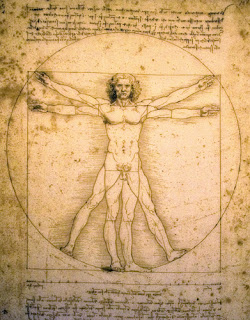
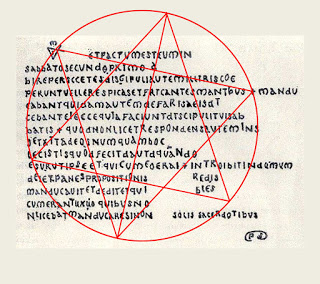
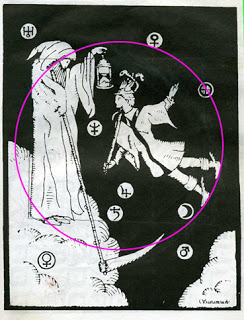
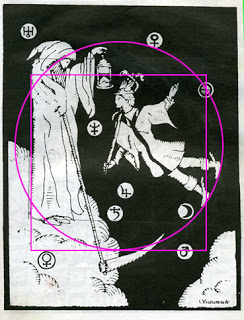
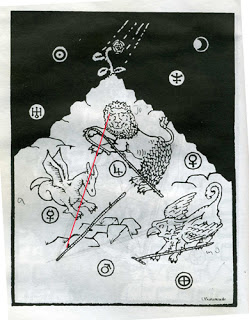

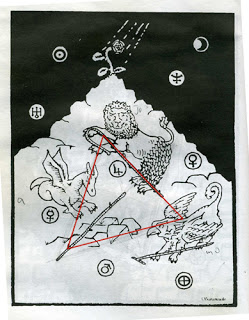
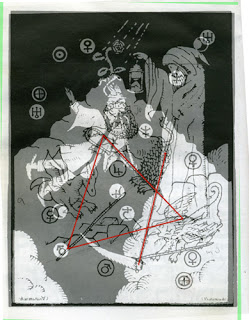
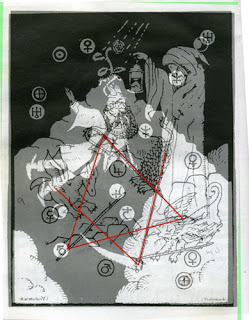
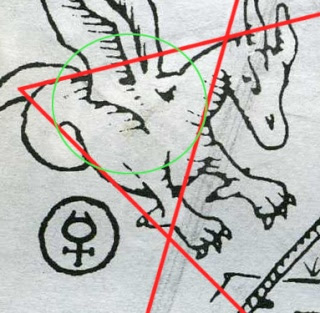
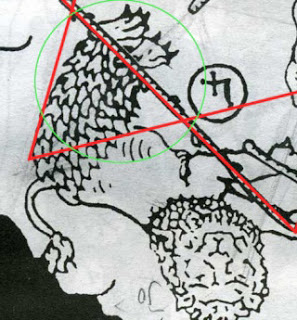
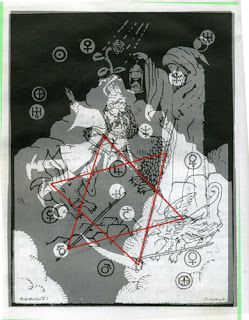
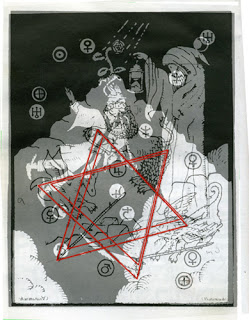
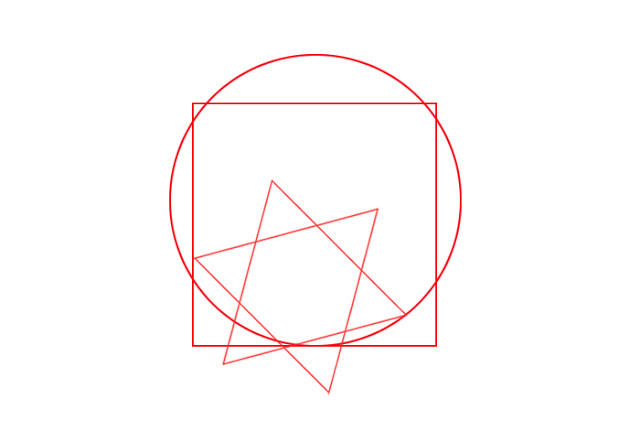
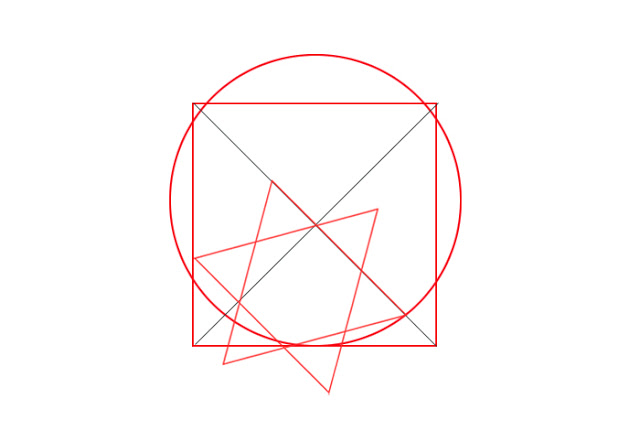
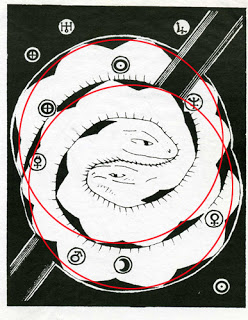
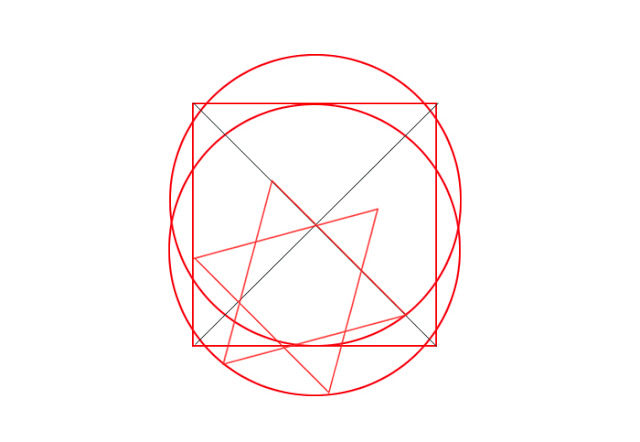
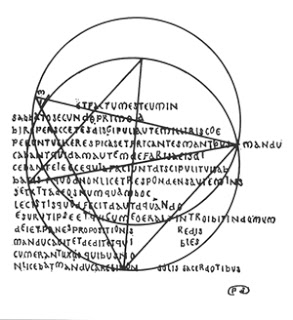
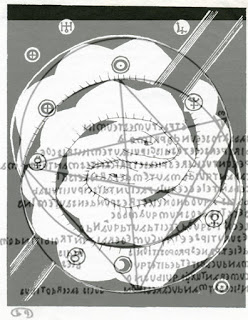

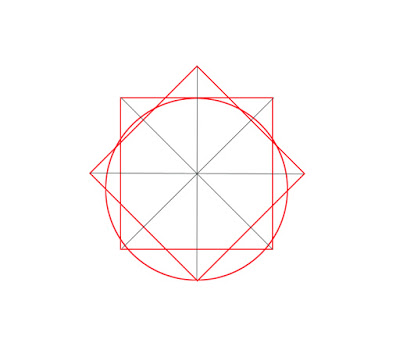
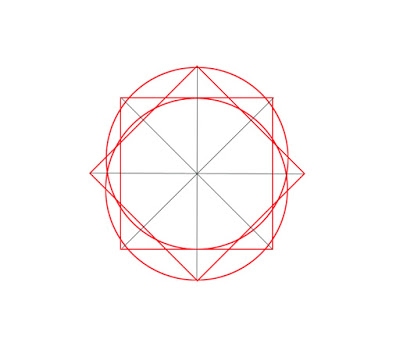
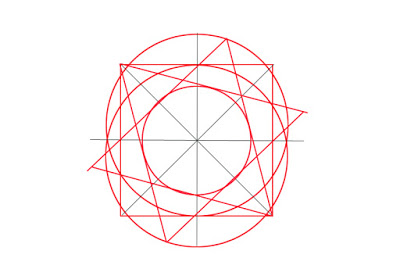
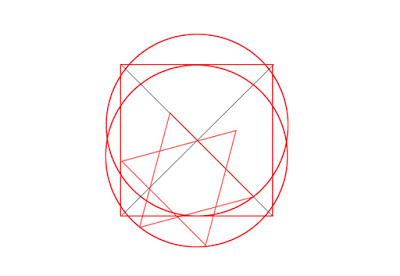
That made my brain hurt, I think I got a cramp.
Hi JL— Sorry ☺. There was a lot to expunge here without leaving too many holes. My hope is to establish a somewhat common presence to these ideas about the geometry because it doesn’t seem to end with this or Poussin or Teniers. Davinci has another work with the same tilted hexagram I found, “The Virgin of the Rocks.”
Others have demonstrated it also in the work of Vermeer.
It’s a great article, Hayward. I was very glad to share it here. Thank you.
For those who worked on the Maranatha puzzle, or are familiar with Sacred Geometry and the mystery of Rennes le Chateau, it gives much to think about and consider, which is always welcomed!
I need to delve into it all further….
Thank you Jenny, as always! It is a great privilege to be able to share these ideas on Mysterious Writings.
As I mentioned in the article, I do think it is really rewarding to pull out a compass and a straight edge (or an angle square) and to reproduce these geometric forms for one’s self. When someone else shows the image it may seem quite interesting, but when you get to do it yourself it is a real “aha!” experience. Take half and hour, maybe use some graph paper to make it easier, it is a great thrill.
Maybe it appears in various works of art as it was a technique taught to the artists at the time? Given D’s articles on the Seven Liberal Arts, if the artists were classically taught and the geometric shapes represented some form of anagogical idea, then it makes sense that it appears to have been common practice to include them. Also, doesn’t an equilateral triangle and a circle lend itself to finding Phi – so also then giving the artist a simple way of creating images in relationships based on Phi (http://www.maths.surrey.ac.uk/hosted-sites/R.Knott/Fibonacci/phi2DGeomTrig.html) – thereby creating what they perceived as being pleasing/proportional images?
It doesn’t have to be Masonic, it doesn’t have to be anything more than an artist applying simple rules to his art.
It doesn’t appear to be Vermeer (http://classic-web.archive.org/web/20030704024026/http://www.vermeersriddlerevealed.com/more_info.shtml) specific…or Poussin or…
I wonder as well how many people would have come to the ’tilted star’ if it hadn’t been pointed out first? Doesn’t it become a bit like cloud spotting – someone points out a shape in a cloud that you then also see after its outline is described – but would you have seen it in the first place without that prompt?
So was it ever any more than an artistic device to create proportional images and to embed an anagogical symbol? If it is some ‘secret’, then ask yourself ‘why artists’ – why would so many artists appear to use the symbol? If on the other hand it was just a reflection of their studies.
HI Horatio-
We can only speculate, but one real possibility is that yes, this geometry was something “acquired” as a skill and was popular for artists to demonstrate in their time. It could be some kind of hidden proclamation for others to identify with, or it could be something that created an assumption that the artist was involved with some kind of knowledge divested from some hidden source. A guild secret? A subject divulged to those developed in understanding its meaning? These would be only my guesses, but there are other possibilities out there.
It does seem that once you set out to find a tilted hexagram, they pop up in various places. One could try with any Renaissance painting, but it doesn’t always work. When it doesn’t, there aren’t any identifying points of reference. And this is what makes the difference between cloud spotting and spotting a real intention. It just doesn’t work if the intent of marking it is missing.
Although I agree that some of them would be hard to find, given the basic composition of the works in question, keep in mind that the first tilted hexagram I mentioned above was found before knowing about the subject. I didn’t know anything about it at the time. It wasn’t until D mentioned it in his demonstration that I made connection to what I had seen earlier. Just pointing it out that maybe it is possible.
I can’t find any hard evidence pointing to this subject being a solid factor in an artist’s education during the era, but the general claim is that through the classical arts and sciences, geometry would be one point of emphasis. Then it would seem that this “stage” of geometry might represent a kind of high point for the individual learning about it. My belief in this possibility stems from a philosophical-geometric point of view (and this could perhaps be traced back to Greek origins) wherein these shapes are identified with certain progressions (or states) of an individual’s personal growth and evolution. The reason lies in WHY an emphasis on well-rounding the individual through the 7 arts and sciences exists; to balance and stabilize an individual on a mental and emotional level. For their overall well being.
To put it in context, each trade had their own ‘secrets’ – that is where speculative masonry developed from – from the basic structure of operative masons who used an apprentice-master grading system. The techniques and skills used would be closely guarded in each discipline – be that masonry or art or alchemy. The guilds were akin to secret societies (http://www.medieval-life-and-times.info/medieval-england/medieval-guilds.htm). Sop the same in each trade. So when perspective was introduced into art, that ‘technique’ would have been guarded – as were the composition of certain pigments etc. The ‘secrets’ were what made the difference between an outsider, an apprentice, a fellow and the master. And the ‘master’ exhibited and proved his skills in his ‘master piece’ – and he then went on to teach his apprentices. As things like proportion and perspective are geometric in nature, I’m not overly surprised to see geometric constructs in art. Didn’t D himself also say that the Poussin painting had pin prick holes? See http://www.essentialvermeer.com/fakes_thefts_school_of_delft_lost_sp/vermeer_theft_04.html#.WB2dVdbUiV4 – so would it be sensible to assume that artists were, as part of their instruction in their art, using geometry in art as a matter of course?
Then add the anagogical layer – if the ‘artists’ also employed the Seven Liberal Arts (and the arts were part of the apprentice training), then could the tilted hexagram – using a circle (G_d), triangle (Trinity) and square (earth/man?) also be totally understandable?
I understand your point and yes, I would agree with all of these issues you’ve made about the possible connections between the techniques used and knowledge learned within each specific art or trade. The main stepping off point from that however, at least in my mind, is the moment when the trade or guild ‘secret’ transforms into becoming a speculative or philosophical one and no longer a practical or operative one. This would occur, I would assume, when an understanding of its meaning (as you rightly introduce) in an anagogical manner has developed and its members are no longer looking at the subject from strictly a practical (literal) level any longer. The issue of “what it is” in fact that makes the tilted geometry understandable in this way would then prove to be the entire course of the individual’s approach to a full understanding of it, if we are to assume that its highest level of meaning were attainable.
Also, I agree with the designations you have provided would form the basis for this understanding. I would slightly modify them with the circle being God/Higher, Spiritual Self and the square being Man/Earth to put it in a slightly more alchemical context.
As I hinted at earlier, I believe it was thought that the 7 liberal arts and sciences were a means to prepare an individual for this understanding, not necessarily something to be applied in a direct fashion. The Latin root of the word liberal is liber, meaning “free”. Thus these ‘arts’ were considered as training for the “free man”. They were not simply understood as tools to give advantage to an individual, but to provide to them the broad means of being able to weigh and balance disparate aspects of their personal psyche. The goal of which was perfecting them.
The philosophy for such a moral approach to education goes back quite far, even back to the ancient Greeks.
The move into speculative as a reason for an image/symbol assuming a different ‘importance’…ok – but think about what you’re then implying. If the geometry in a variety of different paintings by varying artists is the same – and it appears to be – are you saying that it wasn’t just a guild secret / anagogical construct and that the painters who embedded that image belonged not only to an ‘artists’ guild, but also to another ‘speculative’ organisation that venerated that image? Does that seem likely?
How many ‘speculative’ organisations are you aware of that stemmed from an operative guild? Just the one? So are you saying that it just so happens that all the artists that embedded the symbols in their paintings were Masons? An organisation that didn’t really establish itself until after some of the artists in question were dead?
Your assumption regarding the geometry from a historical position is that it possibly served the purpose only as some kind of ‘trade secret’ that has some ambiguous, unknown purpose, but only likely something taught to students for no reason other than for the sake of artistic composition. I’ll ask you, does this seem likely? To me it doesn’t. Is there proof that this shape, in hidden fashion and while being undetected until someone has “pointed it out you” has any effect on the viewer and thus a necessary or successful composition device? There is a known and established history of artists since the Renaissance using geometric form to generate composition, but not this specific form, from my knowledge as of yet. If you have such evidence I would love to see it.
Since you had introduced the idea of a secret thing pertaining to the knowledge of certain ‘guilds’ I simply took the notion and ran with it, using the familiar language used to describe the advent of Freemasonry from its origins in the practical moving onward to the speculative. Did I say anywhere that they were Freemasons? No, I did not.
As much as I respect and appreciate Freemasonry, it just isn’t my bag. It is however, well known that since the Renaissance there had been a flourishing of esoteric ideas and concepts that became quite popular. There is of course alchemy, the introduction of the Rosicrucian movement (quite near the time of Poussin actually), developments in the illustration of Kabbalah, in connection with Christian, Neoplatonic, Pagan and Gnostic ideas just to mention a few. Many of these things would have been far pre- or proto-Masonic, and even such there are traditions which have survived; not leaving Freemasonry standing alone.
So….. What does Forrest Fenn know about this, and why does this exact geometry appear at the end of his rainbow? I mean circle square, circle triangle, with the exact overlaps of the circles.
Hi C.M.R.- I haven’t been following Forrest Fenn’s work closely enough to know your reference. Could you please show me where this is found? An image?
Thank you Nate. It is very nice to hear from you again!
I have to agree with you- everyone will approach the idea using their own frame of reference as constructing its general meaning, and hopefully base a higher sense of appreciation upon this fact.
I often go back and forth trying to understand what it means on a personal level (assuming my understanding is at all sound) and then trying to figure out what the understanding was that others held in the past (no easy task, I know). But I think that in attempting to do so it (for me at least) helps to frame its significance as something that is both a product of indisputable fact (the exacting nature of the geometry) and that which we have inherited from the pool of our collective history.
All symbols are subjective. Even number. I can write 30, but without knowing which base, you have no way of knowing if that’s thirty, three, foty-eight….anything. Visual symbols are no different. Letters mean different things – images mean different things. Skull and crossbones – what does it mean? Mason? Pirate? Memento mori? You have to be told what the symbol means to that group before ‘knowing’ how to use it. I write oui or och – and what does that mean in English? – but it uses the same symbols. But if I tell you that is French, then you have a base reference. Memento mori – case in point. Some symbols can get totally confused – staff of Hermes and that of Asclepius – where groups misappropriate a symbol.
I disagree with the idea that all symbols are entirely subjective. There are actually two components are used to construct meaning with regard to symbols in relationship to their cultural meaning. If you look to the work of Roland Barthes for example, he used the Punctum and the Studium to explain this idea. The Studium pertains to the cultural environment surrounding the idea (the part that frames it and give it context) with the Punctum relating to the personal aspect affecting the individual psyche in response the symbol or idea. In other words, we might develop our own personal response or interpretation to things based on the developed or learned history of experience in association with it however, the language aspect of the thing in question was not our own invention. It has a history of which we have inherited and thus we actively participate with in affirming or reinforcing as we use it or attempt to understand it. This understanding is further reinforced with trying to more fully understand the context surrounding it.
So yes, without context in the way that you described the things above. all of these symbols would have little significance. All that is missing is the context.
Give me one symbol that has meaning of it’s own – without ‘man’ ascribing that meaning.
I feel the confusion comes with the use or definition of the ‘word’ symbol, as it seems to suggest Man creates all of them. But there are some things which ‘JUST ARE’…… And to me it is not ‘MAN’ ascribing meaning to those things, but trying to UNDERSTAND them.
I feel In Geometry and Mathematics there are limitless ‘symbols’……… A triangle is a triangle whether in this world or another. The Golden Ratio, shown in a spiral growth, the same. One item, seen as one thing, and so on.
I think a mistake or a confusion is being made to say Man creates the ‘Symbol’ of a Triangle, Square, Prime number, etc. THEY ARE with or without Man doing anything to them. It is the understanding of them……
I feel they, their Nature, have meanings of their own……. but it is true Man will always differ in their thoughts on them…
I don’t think we should be so quick to say, A Triangle has no meaning without Man’…… Man doesn’t have to ascribe meaning to ‘this symbol’ for it to have one.
“Geometry is unique and eternal, a reflection from the mind of ‘the Creator’” ~ Kepler….
They are God’s symbols…. (to me. I know others might differ…)
It might prove to show we can never really know God…..or the meaning of his Truths….. but I’m fine in the mystery and the search….. 🙂 Love it actually.
I think that would depend on the definition of symbol. If you’re talking about a symbol being an abstract representation of ‘something else’ – ie all letters are symbols – they represent sound. All numbers are symbols. Images aren’t symbols per se. Geometric shapes have ‘properties’ (that is a given as that is inherent in the term) – but they do not ‘mean’ anything unless you belong to a group that uses that shape to symbolise something else.
You say ‘……I don’t think we should be so quick to say, A Triangle has no meaning without Man……Man doesn’t have to ascribe meaning to ‘this symbol’ for it to have one……’ – well what meaning does a triangle have that isn’t subjective? What meaning do you see in a triangle that everyone else also sees? A triangle has objective properties, but not meaning – unless you subscribe to an idea such as that it represents the trinity or some such – but that is totally subjective.
I’m not sure that: ‘…“Geometry is unique and eternal, a reflection from the mind of ‘the Creator’” ~ Kepler…. …’ has any bearing on symbols – unless you’re saying that Geometry symbolises G_d in some way – in that is shows an aspect of the creator – but that in itself is subjective anyway, as not everyone believes in a ‘god’ do they?
Can you give me an example of a symbol where the symbol is an abstract representation of another ‘thing’ that isn’t subjective then? I can’t think of one.
Hence the issue with the tilted hexagram image – unless you ‘know’ what it represented to the person who used it, you can’t even begin to guess. Even where we share the same symbols to represent the same thing, we still get confusion. Trunk or boot, sidewalk or pavement, color or colour? Are happy people gay? Are gay people happy? If you’re bad are you good? If you’re wicked are you really good? …you see what happens when symbols get misappropriated even on a small, simple scale. Without knowing the context even simple every day words can be confused.
You yourself even imply that your ideas are subjective as you say ‘… They are God’s symbols…. (to me. I know others might differ…)…’. That last phrase makes it a subjective comment doesn’t it?
I think the main point here is being overlooked, or perhaps maybe I am missing the point, lol.
What I am talking about in relation to the specific symbolism here (and I am using this term it in the sense of it’s definition wherein a visual thing stands to represent another thing), has to do with the idea that the placement of it does not necessarily serve a compositional goal primarily (which anyone is free to agree or disagree with), but stands to be ‘read’ in another way to communicate with those who recognize it. Thus in my hypothesis, the “objective” aspect of such a symbol (in the semiotic sense) has to do with the frame of reference surrounding it, of trying to establish a context around it to align our understanding with it (which we have not yet done here whatsoever, nor has this even been the attempt of the article above). However, your example of stating that a letter or number is purely a subjective symbol is not entirely true, since we can be familiar with how it has been commonly used and continues to perform certain communicative functions in the present. There is therefore an objective reality to the symbol here then, in the sense that we can simply be observant of what it’s meaning has been to those who have used it, aligned with our familiarity and understanding of it through our own experience with it.
For example, if you are an English speaker at present, you can go back and read a text preserved in Middle English such as Sir Gawain and assume that you probably have a good idea of what the text is stating, based on your understanding of the symbols used to create words with meaning, as you have inherited an understanding of them in the present. This, despite the fact that the language being used is quite different or unfamiliar to us in the present. A simple sense of inference would allow you to accept such a possibility. Would we then state that any attempt to to understand the text would be false based upon the fact that there was no one to tell us what the original meaning of letter, words and overall text stood to represent? Probably not.
So in this way, I see that this component symbol (and not just the tilted hexagram alone, because that is not solely what I am speaking about here in the article) is likely being used in a similar fashion; to communicate an idea. I am convinced of this, since there is doubtful any other reason to establish the basis of presenting such a shape (and since I would argue that an impression made upon a viewer of art through composition IS subjective), especially when seen to occur through the work of many in the same field and with proximity to other motifs and imagery that provide a basic context for it.
And here is the point where we agree. I think that to know the particular nuance of the form being used in communication, we do need to understand its context. Or, we should at least be familiar with it if we are to being to make a hypothesis. I do think that there are certain things that establish a direction in this regard, and I have attempted to address some of these ideas in other articles I’ve written here.
This article does not attempt to prove the meaning of the shapes through knowing the motivation of those involved. However, as you had attempted to start with earlier equating the circle with God, the triangle with the Holy Trinity, and the square with Man, we can again see how a familiarity with certain motifs can allow us to make a reasonable stab.
Very well said, Hayward. I think you present powerful facts, and they shouldn’t be taken out of the context you are presenting it. Excellent. Thank you for this.
Well said, Jenny.
The symbols were there “before man”. Man did not create the perfect circle, the perfect square or the spiral etc.
They Are the signature of I Am.
http://www.holtz.org/Library/Images/Slideshows/Gallery/Cosmic/Hubble%20gallery.jpg
IMO, geometry is symbolic of the exactness of physical laws and the Perfect Order of Eternal Laws.
Understanding it all…from man’s lowly vantage point…is clearly not a simple exercise.
Still…here we are…each of us…created in His image…to experience it.
With any “luck” we will understand some of it while we are here…which will enlighten our journey.
https://www.biblegateway.com/passage/?search=Psalm+104&version=KJV
“Hidden” geometry is everywhere you look in Nature.
These are hidden from man’s view…unless you have a microscope.
http://neurodope.com/wp-content/uploads/2014/11/Diatom2-1.jpg
http://chaoticmind75.blogspot.com/2013/08/my-technique-for-snowflakes-shooting.html
No – you’re confusing completely different things. You recognise old English because of similarity – but you still need to know what the ‘symbols’ mean to be able to read in the first place. If I presented Beowulf to you in Arabic, you’d be stuffed unless you knew the Arabic symbols for their letters. So letters are symbols. I can read old English because the Latin alphabet is relatively consistent. I can pick out some words because of similarity. I could the same in some Latin and French and Spanish – but if you gave me text in Thai, I wouldn’t even know where to start – as I haven’t benn taught those symbols. Numbers are symbols. Words are symbols that represent ideas. Do you honestly think that someone could have translated Egyptian Hieroglyphs without the Rosetta stone? You have to know what symbols mean. That is what school teaches you. They teach your local alpahabet and numbering system. If I took what I ‘know’ and go to an Amazonian tribe that has no knowledge of European letter or number, I couldn’t write or express written mathmatics without first explaining the symbols used.
Do you think any alien would understand any symbol we have, without having that symbol explained to them? Show them a cross – it will mean nothing. Show them the Stars and Stripes, they will not have a clue. Show them a maths book and it will mean nothing at all. Isn’t that the precise problem they had when they sent out Voyager and had to decide what to put on the plaque? What is distance to someone who travels faster than light? What is size when the creature is as big as earth or as small as an atom?
Of course the tilted hexagram is used to represent an idea – even if it is the equivalent of a folly. So is a crucifix – it represents – symbolises – an idea. My point is that you can’t KNOW what that idea is unless you’re told. For example FF = 255 in hex. I know that, and I recognise that. I know that because I was taught it. If I show FF to anyone who hasn’t be taught that particular thing – and even if they have been taught it, they would also still need to know the base – as FF in a higher base would obviously mean something else. I could write oui and a French speaker would understand – but a non French speaker wouldn’t.
And as for the last paragraph – that I think makes my point. You’re cloud spotting. You see what you want to see. You see a symbol that you don’t undersatnd and then guess as to its meaning. I guess by mixing different symbol methodologies. I mixed Christian and masonic and maybe a bit of mixed up alchemy.That is fine. BUT, you can never KNOW what the symbol means without being told. The symbol may not even exist beyond Maranatha. Poussin may have used geometry in his paintings as an aid for perspective and balance – and as a by product other geometric shapes then appear to be in his works. Ditto Vermeer and any other painter. Maybe that is why the tilted hexagram appears so common.
I think that you’ve grown so used to symbols that you take them for granted and have started to see them for the things that they represent. You see a Red Cross and see ‘aid’. But a Red Cross means nothing in itself. Nor a Green Crescent or a Staff of Asclepius. A symbol is shorthand that’s all. And it’s only relevance is to other people who know or want to learn the same shorthand system.
To end on a lighter note but in the same vein – it is said the Shakespeare introduced loads of words into the English language – but how risky is that for a playwright? As how could his audience understand a word they’d never heard before? So did Shakespeare invent the words, or was he simply the first to document their use? For what use is the symbol of a word if no one knows what it means?
Horatio- It seems to me that you are just trying to insert yourself into the discussion with cause to block the forming of a conclusion before one has even been formalized. Your response is thus preapprehensive. In effect as if saying that since we can not ask the source directly for their meaning then there is not even any point in looking at drawings or similarity of evidence of any type or in any form to try to base our own understanding. This in fact, if it is truly the case, would be your opinion. My opinion, and perhaps the opinion of some others, is that it is worthwhile and we will continue to look at it. If you don’t like to look at these things, then of course you don’t have to, and I can accept that you don’t agree with this interest in showing relationships, but please do not suggest that anyone should not have cause to investigate if they want to simply because you don’t think that someone is capable of making a determination for themselves. You don’t’ have to engage with it if you don’t find the geometry or its sources compelling. You can also just wait until such a presentation has actually occurred and then debate the points forming that argument.
Using your own examples however, we can see that your definition of ‘being taught’ is not the only way to attempt to identify with the meaning behind symbolic representation. When NASA launched their interstellar probes for example, they placed messages in binary code because they thought that if an intelligent species were to discover these records they would be able to infer the meaning of their messages through recognizing a communicative system through their capability of reason, despite their being unfamiliar with human-based forms of symbolic communication. When scholars worked to decipher the Rosetta Stone, they used their knowledge of ancient Greek and Demotic (pre-Coptic) to infer the meaning of the hieroglyphs found on the same stone; while hieroglyphs in themselves are now known to be figurative, symbolic and often phonetic (simultaneously) in nature— i.e. they do not work precisely in the same way as does phonetic language systems. Thus again, they were able to infer their meaning from one piece of evidence, when the entire lexicon of Egyptian hieroglyphs was not available. The rest of the system which was not present on the stone has since been established based on inferences stemming from the context of what had previously been determined in its isolated context.
Your response to the example I gave of Middle English and Sir Gawain was that the language is similar enough and letters the same so this enable one to understand their meaning, yet this doesn’t account for when one encounters a word or syntax which they are not familiar with, or one that has a different inflection than how the (similar) idea might be expressed in the modern sense. We will thus infer the meaning of the unknown word based on the context of what we already have established.
In each case exampled above, there is not an agent of authorship around to “tell” one how to establish the meaning. The means of apprehension of the unfamiliar word, symbol or system of language in each instance is through inference; based on familiarity with the nature of general expression as well as the context of its surrounding information. The same goes with how to understand the meaning of an unfamiliar word in Shakespeare –even though he invented new words and placed them into his work– we have been capable of inferring their meaning through their available context.
Your position seems to take language and symbols, as well as the beings responsible for their agency, as being incapable of evaluating evidence through any offering of intelligence. That they must be simply programmed with the correct definition or vocabulary in order to understand symbolic language.
One of the rudimentary forms today used to both educate and determine levels of cognitive intelligence is an ability to make determinations through systems of inference. In elementary schools, inference is a primary means to develop a child’s vocabulary. The ability to recognize systems of logic through patterns or modes is also used to determine intellectual ability and can be applied to how an individual can utilize the ability to another system. To ignore this fact also ignores the possibility that intelligent beings can detect the presence of intelligence found isolated from its source and begin to construct a system of communication even without initially knowing the original system.
To prove this point, you had also made an inference here in response to the article. Through reading the presentation of the various forms of geometry and examples of where they were found and who were its authors, you began to infer what my position was in terms of the motive of the original authors, also that I have somehow communicated an explicit understanding of the meaning of the symbol. This, even though I made no clear or exact statement telling you my position. You were thus able to determine some sort of direction as to a possible approach and used this information to form some sort of conclusion on your own. Based on your own definition, this would be a subjective position. A truly objective position would be that you simply have not seen enough evidence to reach a reasonable conclusion.
In this light, answering the question of whether or not there is a symbol that “has an inherrent objective meaning/property” (in the universal sense) is simply not a applicable angle to the discussion. Nor would any answer allow for us to make any such determination. To consider, if we were to provide one such example, what would that prove? Are we to assume that if we did we would acquire automatic ability to determine the potential meaning of this symbol? No, it wouldn’t. (Just because there might exist a universal symbol does not mean that this symbol is a universal symbol) If we weren’t able to, are we to assume that since there is no example available we are incapable of determining the potential meaning of this symbol? No, we can’t. (Just because there is no symbol with a universal meaning does not mean this symbol has no intended meaning).
What I do think you have successfully accomplished so far is to help establish what has already been mentioned (and I think this is why everyone is mentioning circles).
All symbols have two parts: a signifier (the symbol itself) and a signified (the thing it represents). As you have attempted to argue, (albeit not directly to be honest) these things are independent of each other and not entirely exclusive. The signifier does not come with any representation automatically attached to it, nor does the signified thing automatically have a symbol to accompany it. The establishment of meaning or signification is thus applied through a process of socially upheld conventions. This is invariably true.
This does not however negate the presence of intelligence found through the noticeable organisation of symbols nor does it automatically invalidate the ability for one to make an inference as to the representation of the symbol from its available context. (Which of course, has not been done yet)
JC1117,
I think we’re talking completely different things.
Circles and spirals are not symbols. They are shapes.
When I’m talking about symbols I am talking about the use of abstract – refer to the definition here (https://en.oxforddictionaries.com/definition/symbol).
0=nothing (0 is a symbol meaning nothing) but doesn’t exist in Roman number symbols.
a=the sound of ‘a’ in Latin alphabet. IE ‘a’ is a symbol for that sound. But it is not in Arabic.
a crucifix is a symbol of Christ to Christians, but means nothing to an Amazonian Indian who has not heard of Christianity
a triangle may be used to represent the Trinity, but in itself a triangle (as in all geometric shapes) means nothing
So what I am talking about in way of symbols isn’t shape, but the use of one thing to represent another or an abstract thought. Does that make any more sense?
So I repeat – can anyone give me a symbol that is universally recognised? If not, I stand by my point that all symbols are subjective. The symbols in themselves mean nothing – the only only relevance they have is to people who have been shown what they mean.
oh, JC1117, I love your phrase, ‘they ARE the signature of I AM’…… I would so agree with that…..
@Horatio- I began my reply saying it depends on how we each define words in case you missed that………but your first question was- “Give me one symbol that has meaning of it’s own – without ‘man’ ascribing that meaning.” GOD is not MAN (or whatever you believe ‘created’ the triangle is not Man) …… No matter how many questions we may think of, a Triangle, as ONE example, has ‘meaning’, with or without your full understanding of it. It is a Truth. Truth is meaning.
And I’m sure you might continue to question, which is wonderful, and I leave you to it….. However, I’m content in my reply to your first question, whether you agree or not. Your Truth does not have to be mine, or mine yours, and I haven’t any desire to make you feel so.
Best of luck to you……..treasure the adventure.
Hello, Horatio.
I think all you have managed to “prove” in your argument is the obvious…the most benign, generic understanding of a “symbol”.
All you have proven is that you can take a concept…ANY concept…and subdivide it…and compartmentalize it…and so thoroughly isolate it that it can only be described by the simplest definition. You made YOUR point.
I thought the discussion was about hidden geometry…circles and spirals and perfect squares…(“shapes” as you call them)…and ALL of their meanings…knowns, unknowns, unknown-knowns, esoteric, mystical, scientific, religious…or otherwise in-your-face meanings.
No explanation to any mystery is ever off the table…until we KNOW the answer.
@Jenny
What is the meaning of a triangle then Jenny, other than its objective properties?
And if my Truth does not have to be yours and your Truth doesn’t have to be someone elses’ – then I doubt if that ‘Truth’ is Truth at all. Just a belief. (refer https://en.oxforddictionaries.com/definition/truth). I agree there are accepted truths (I think most of scientific ‘fact’ falls into that category) where more evidence forces changes in the definition.
@JC1117
I’m obviously not explaining myself too well, so I’ll try again. The dictionary defines symbol. That is how we use words. We have to use the words in conformance to the dictionary, or else total confusion can follow (as I tried to show with the misappropriation of gay, bad, wicked etc). OK? So there’s a definition of the symbol – the word ‘symbol’ (yes, the word symbol is a symbol). Shapes are then shapes. Shapes are not symbols – although they can be. IE a triangle to a Christian may symbolise the Trinity. Are you still with me? So a shape can be a symbol – but then there would be a definition of what that symbol means and to who. So symbols have meaning within context. EG a word (which is a symbol – and the dictionary provides the accepted definitions of those symbols) can change meaning (and they often do) – so context is relevant. Durex is a brand of condom in the UK, but sticky tape in Australia. Bad to certain groups can mean good – but that is a recent thing. So time, location etc can affect the meaning of a symbol.
So what symbolic meanings are you applying to circles, spirals and perfect squares – because (which I think in a way proves my point) I see no symbolism whatsoever in those basic geometric shapes.
@anyone
Which takes me full circle to….. can anyone then give me any symbol where the meaning isn’t subjective – as I am not aware of any. AFAIK all symbols depend of the person having pre knowledge of what that symbol means to interpret it correctly in context. So without knowing what an artist (or group of artists) intended by embedding symbols in their art and what then those symbols mean, it is all just pure conjecture.
Bravo, Horatio.
Which takes you full circle…to…talking in circles. I already explained what those hidden geometries symbolize to me. It appears that you are too busy listening to yourself to listen to others.
Congratulations. You know how to open a dictionary. I acknowledged this proclivity of yours already.
What have you learned with all of your “point making”? That all babies are born without knowledge…especially innate or instinctive understanding of particular “symbols”? And every tiny piece of information they ever “learn” throughout their lifetimes will be subjective?
What did I miss? That bad is good and good is bad?
You can continue to argue that case all you want. Personally, I won’t argue with you. I am content with my knowledge AND my imagination.
BTW, there are many definitions and synonyms for both “subjective concepts” in the dictionary…if you care to look them up.
JC1117,
‘…Which takes you full circle…to…talking in circles. I already explained what those hidden geometries symbolize to me. It appears that you are too busy listening to yourself to listen to others…”
Do you know the difference between objective and subjective? As surely what something ‘…symbolizes to you..’ makes it subjective doesn’t it?
So if you have a symbol that has an inherrent objective meaning/property, I am still listening.
As for ‘…. And every tiny piece of information they ever “learn” throughout their lifetimes will be subjective?…’ – of course not. Surely you learn objectivity? A property that is part of the object and that doesn’t change no matter who views that object? That is a vast part of learning.
Finally ‘… Personally, I won’t argue with you. I am content with my knowledge AND my imagination….’ – glad you are. But ‘your knowledge’ may then not be knowledge at all may it (as knowledge tends to need facts not subjective beliefs)? But if you’re happy then carry on regardless – I am all for happiness. (And I use the term/symbol ‘knowledge’ as in https://en.oxforddictionaries.com/definition/knowledge).
I find your post slightly odd – as I detect a note of hostility. And surely all you had to do to prove the point was to give an example of a symbol that is not based on a subjective view. IE where the symbolism is inherrent within the object or definition of the object itself (ie so all people recognise the same symbolism irrespective of age, generation, nationality, religion ….etc)
@Horatio, I just smile and shake my head at you; And I hope you won’t take offence to what I share below, because– how long have we known of each other? over ten years now? Wow!… and I have learned you love to question…..I feel like you love to pick everything to death….lol…. and so maybe that is why I visualize the following of you (in a good way, please know that). (I share to hopefully make you smile :))
I see you like a Vulture (and I’m picturing the ones from the cartoon Disney Jungle Book- all in fun…they sing, ’We’re your friends, We’re your friends, to the bitter end)
But I imagine you like a vulture, circling around, looking for prey to pick to death. Once done, you may be satisfied for a moment, but must begin to circle again, to look for something else. It’s all good. I’m sure you realize the prey have often times left their ‘bodies’ there to be picked to death by you, but moved on happily to new life and adventure.
It’s just an image in my head….lol…. (and in fun…please take it that way)
I appreciate your questions, as they do offer different perspectives. I’m sorry I’m not as wanting to delve into the endless spins though. Or actually I might be, but not to prove a ‘right or wrong’; only to offer thought and to let each decide on their own.
Anyway,
How are you? What are you working on these days? Anything particular?
LOL! Mmmm…that sounds good, Jenny.
Now I’m hungry for some ribs…succulent, slow-cooked ribs with meat that just falls off the bone. I’ll circle around the kitchen for hours…just waiting to get my claws on some of those ribs.
I heard about a delicious rib recipe made with Dr. Pepper…which I haven’t tried yet.
That sounds so good to me. Where’s the Like button? You know…so I can press it.
How ’bout you, Horatio? Do you like a good rib now and then?
I very rarely take offence….as personal comments on forums seem quite commonplace more’s the pity.
I just find it so odd that in all the discussion so far, no one has simply given an example of a symbol that is not subjective in its interpretation – especially given that the majority of people have disagreed with my point that all symbology is subjective. But hey, c’est la vie I suppose.
No, not working on anything. The LRB lies gathering dust in some drawer somewhere…and the closest I’ve come to reading anything mysterious has been Conan Doyle….
Odd things happen. 🙂 Yes, such is life.
Give me one that isn’t totally subjective please – as I can’t think of one.
LOL, Horatio!
You’re funny.
Just for the record…I never “disagreed” with you. You make a very simple, valid point…again…and again…and again. 🙂
However, your “point” does not answer the question, “Why?” …nor does it address the metaphysical properties of symbols (and hidden geometry) and account for their power and mystery.
http://1.bp.blogspot.com/-B0zPlCtFwqE/TxLbOFVX30I/AAAAAAAAALw/jpyXzPKqELc/s1600/19+-+Lengle+ManyWaters+believetosee.jpg
https://www.biblegateway.com/passage/?search=1+Peter+1%3A7&version=KJV
Sorry JC1117 – I thought that when you said:
‘…Well said, Jenny.
The symbols were there “before man”. …’
That by inference that implied that symbols had a meaning without man. IE that the symbol had an inherrent meaning. My mistake.
As to ‘Why?’ – why what? Why did Poussin put that symbol in his paintings? First of all, ask the question ‘Did he?’. Read up on how many different shapes people have seen in paintings – are they all there? Were they all intended? How can you know? I would ask is it just as likely, that the artists were taught perspective and proportion – and as part of developing that in art they used geometry (which is used in both perspective and proportion). Now, when looking at paintings, people ‘see’ geometric shapes. They may have been intended or they may simply be the viewer creating an image/shpe from a few lines that may have existed. much the same as how our brain likes to match patterns. It ‘sees’ teapots in clouds and faces in leaves on a tree.
No symbol has power. And any mystery is in the mind of the beholder, not in the object itself. I would also say that is my point anyway – that any mystery you perceive is because you have not been told the meaning of the symbol – as if you have, then there is no mystery is there?
oops – typo. That should read ‘I thought that , by inference, that…’.
Horatio, your original question which I responded to, which you’ve since changed, but was, ‘Give me one symbol that has meaning of its own- without MAN ascribing that meaning….
To which I answered by asking you to consider that ‘a higher being’ (Creator for me) may have ascribed a meaning to, for example, a Triangle. It is what it is, and has meaning.
God/Creator is not MAN, and could have created a Triangle to have meaning, and symbolize that meaning. It is a Truth. That was my thought.
Obviously, if you don’t believe in anything higher than yourself, you would disagree, which is fine, but I do believe in a higher source, and do believe a Triangle could have meaning, and was created to have such, and be a symbol for that Truth….……whether or not we recognize it or believe in it.
My question to you is can you prove that is wrong? I’m not saying I can prove it True, I can’t, and such my continued thought how great mystery is. But can it be proven False? (and not by a spin and play of words)
Round is the higher power’s creation( our circle of life). Within these parameters all shapes can be created. Stemmed from all of our freedoms of thought and imagination.
But a triangle is not a symbol, it’s a shape.
It has properties. But it does not symbolise anything.
If however you say that a triangle symbolises something, then you have ascribed that something to the triangle. So that symbolism becomes subjective. A triangle dos not inherently have that symbolism.
If you say all things then symbolise something else in G_d’s great plan then great – but you then can’t say what it symbolises can you (as you can’t know)?
So if the triangle does symbolise something – what does it symbolise?
…that was in reply to Jenny by the way…
That was my question…..who can prove ‘a Triangle’ is not a symbol of God’s and God created it to have meaning- known to him? (or the higher source). I said I couldn’t answer it and was happy to leave it to mystery.
But asked if it could be proved False. Which you suggest it can’t.
I find the mystery wonderful…..and it is so awesome they exist.
As I just wrote to Hayward, my time is limited and won’t be able to continue in the conversation til another time. I wish you all well until then…. God bless….
Jenny,
You said:
‘…That was my question…..who can prove ‘a Triangle’ is not a symbol of God’s and God created it to have meaning- known to him? (or the higher source). I said I couldn’t answer it and was happy to leave it to mystery…’
No one. No one can prove anything if you always add ‘….well G_d may have…’. God may have, G_d may not have. But I’m not G_d and I don’t profess to know the mind of G_d. So I’ll rephrase what I’ve said. In the human realm (where we all exist), a triangle symbolises nothing of itself. A triangle only obtains a symbolic meaning if man gives it one – and then that meaning may change over time, location and in differing contexts.
You’re talking in circles AGAIN, Horatio.
I acknowledge…and believe Jenny does, also…YOUR point from man’s “physical” perspective.
But it’s the old apples to apples argument. We clearly see your apples whilst you openly admit that you know nothing about the “mystery fruit” we are referencing.
And there it rests.
Good luck with your “solid” argument that a man or woman “can’t know” what seems illogical from your commonplace, closed-minded perspective.
History is replete with examples of people who knew things…mysteriously…which were proven to be true over time. These individuals weren’t “born with” the understanding they acquired. Yeah, we “get that”, Horatio…but they acquired their understanding nonetheless.
I’m talking about the Big Picture, Horatio…not your obsessive infatuation with “symbols” not having meanings unless we “imagine” they have meanings.
From a purely physical perspective that is true.
From a Spiritual Perspective it is naught.
Horatio,
Just a thought on why something might symbolize ‘something else in G_d’s great plan’.
I will use the triangle as an example. If you take three sticks and arrange them so that the end of each stick isn’t allowed to touch the end of another stick then you can arrange them in an infinite number of ways, call this chaos. These sticks have no predictable properties and the only symbolism they might have is one that you might give it. But, if you arrange the sticks so that each end touches the end of another stick then you end up with a triangle. Now the arrangement of sticks has order. Order has been created out of chaos. Move the sticks apart again and all you get is chaos, no predictability. Put them back the way they were and order is restored. That ‘order’ has properties, in this case, each junction of sticks has two angles, an interior angle, and an exterior angle. One example of order out of the chaos is that the sum of the three interior angles will always add up to 180 degrees. So, if a G_d brought order to the chaos of the universe then a triangle might be His way of winking at us.
Hayward, I can’t directly reply to your post, so I’ll reply here.
You said : ‘…Horatio- It seems to me that you are just trying to insert yourself into the discussion with cause to block the forming of a conclusion before one has even been formalized. Your response is thus preapprehensive. In effect as if saying that since we can not ask the source directly for their meaning then there is not even any point in looking at drawings or similarity of evidence of any type or in any form to try to base our own understanding. …’
No. What I’m saying is simply that you cannot know what the symbol means. You can infer. BUT as I’ve tried to show umpteen times, to infer you need context. You need to know about location, time and culture. Symbolism is not like shape – whereby the shape has properties that remain static and are inherrent in the object itself. As a symbol is subjective, it may be interpreted today completely differently to how it was intended at a point in time and location. How can you know if you have the right meaning? Is bad good?
You said – ‘….Using your own examples however, we can see that your definition of ‘being taught’ is not the only way to attempt to identify with the meaning behind symbolic representation. When NASA launched their interstellar probes for example, they placed messages in binary code because they thought that if an intelligent species were to discover these records they would be able to infer the meaning of their messages through recognizing a communicative system through their capability of reason, despite their being unfamiliar with human-based forms of symbolic communication. When scholars worked to decipher the Rosetta Stone, they used their knowledge of ancient Greek and Demotic (pre-Coptic) to infer the meaning of the hieroglyphs found on the same stone; while hieroglyphs in themselves are now known to be figurative, symbolic and often phonetic (simultaneously) in nature— …’
Exactly. They could not tell from the symbols themselves. The symbols were meaningless without the Rosetta stone that had the same text in different languages. IE the Rosetta stone was the dictionary.
You go on to say that my standpoint seems to deny the use of intelligence to infer meaning from symbols. I say that intelligence has no bearing. If now I decide to mix the alphabet and change the value of the symbols so that ‘a’ no longer represents ‘a’, but represents one of the other letters instead. And I do that to the whole alphabet. If I now write ‘vgjk’ – what does that mean? How can you use your ‘intelligence’ to interpret it? The problem is H – you don’t have enough data to interpret it – you can guess. Of course you can. Now I’ll also introduce time into this. Let also now say, I change the correlation between my new alphabet symbols on a daily basis – again I write ‘vgjk’ – what does it now mean – AND more importantly does it mean the same as it did yesterday?
You see this change with symbols in your everyday life – you see change in images based symbols, words, letters, numbers. All change over time, location and context.
You did say (I think) in one of your other posts that I had put words in your mouth and that you had not said the symbols were Masonic (is that fair?). I think I used a rhetorical question after you had put forward the move from practicing to speculative societies. Were you then implying that all the artists, where this symbol has been seen in their artwork, belonged to the same ‘speculative’ group and that the symbol is somehow related to that group? If you were, then which group? As again, I repeat that to know a symbols meaning you need time,location and context – and how can you even infer using your ‘intelligence’, if you can’t establish context?
I won’t address any other point from your post here, unless you specifically feel I’ve ducked a point…
Yes, we can infer. Whether or not a symbol is subjective does not mean we are incapable of attaining a reasonable grasp as to its author’s purpose through evidence. The only thing you are missing is the possibility of one being able to determine a fair degree of context, despite what you think is capable. Your issue with seeing no available context might be because you are not enough familiar with the subject. Therefore your adherence to the idea that ‘no one can know what the symbol means’, without having first explored a reasonable argument in either support or in opposition, with this existing as a factual totality, is actually a subjective (and rather closed minded) opinion (IMHO) , and you are certainly entitled to it.
That is when the unwillingness to become involved in investigating a subject might limit the potential to actually develop an understanding of something, whether or not the understanding supports or destabilizes your opinion. Skepticism is necessary and useful, just as long as the skeptic is also willing to turn their skepticism inward, otherwise the skeptic becomes engaged in fabricating exclusivity, which is something the skeptic is precisely arguing against at the beginning. Thus the determination of any interpretation should not be simply static, but dynamic, working with the sense that meaning might possibly be tangible and might not be tangible –determined through inference– if, in fact meaning were at all intended. The alternative is getting lost theorizing within the hypothetical context, attempting to stabilize false tautologies that are external of the subject at hand, as a means of asking other to draw an opinion over whether truth is either possible or not possible. Truth which, so far, your arguments would seem to be in support of the idea that it is actually relative. This relativity must therefore be determined within the conditions or context surrounding the subject and not by inserting external, non-applicable concerns that attempt to determine whether or not the possibility exists to do so.
Before moving forward with any possible frame of reference to contextualize these ideas, I feel that these parameters must be established if we are to get anywhere. If and when I –or anyone– puts forth a statement outlining the structure of an argument, I myself promise to as objective as possible and careful not to draw conclusions without the support of some type of (reasonable) evidence So, when the moment actually does come (if and when it does) we can then have our fun destroying any components of the argument as appears necessary. Each of us can thus weigh the information and make a determination for themselves.
Hayward – you said:
‘…Yes, we can infer. Whether or not a symbol is subjective does not mean we are incapable of attaining a reasonable grasp as to its author’s purpose through evidence. The only thing you are missing is the possibility of one being able to determine a fair degree of context, despite what you think is capable. Your issue with seeing no available context might be because you are not enough familiar with the subject. Therefore your adherence to the idea that ‘no one can know what the symbol means’, without having first explored a reasonable argument in either support or in opposition, with this existing as a factual totality, is actually a subjective (and rather closed minded) opinion (IMHO) , and you are certainly entitled to it. …’
OK what evidence is there that:
1) The titled hexagram was intentionally placed in any painting.
2) If the tilted hexagram actually does exist and was intentionally placed in the artwork and is in multiple artists’ paintings, what evidence exists for the artists belonging to a group where that symbol may have had some meaning?
3) If the titled hexagram actually exists and was intentionally placed in the artwork, what evidence that it symbolises anything at all?
@Hayward, as mentioned, when chatting with you elsewhere, my time is so limited to mid-December, but I hope to continue more on this later; but research I have done supports that Man believed the primary shapes had meaning, and studying them would reveal the Divine. I feel your excellent work as shown the real possibility of this as well. It will be great to combine researches (and with others too) to discover more. ~j
@Jenny- thank you for the note and I always look forward to hearing more from you about these subjects.
What you have described above will be one of the premises behind trying to discover the meaning behind the geometry. Making a solid connection to these examples will take alot of hard work, lol. But based on several key variables and examples I do think it can be done.
Slow down horatio, we are only on step one.
OK what evidence is there that:
1) The titled hexagram was intentionally placed in any painting.
(for the record: If I am to comment on something without having first referencing it through a piece of evidence, I will state it is an opinion just so there is no confusion) (but will probably give a reason for that anyway)
Since you are asking if it were placed intentionally in “any” painting, then we can first begin with the approach of an increased probability through finding it in several examples. As I have presented in the article and as I have outlined directions of how to produce the shape using actual points in the image (both in the artwork and in the script of the RLC document), the shape appears to be reproducible. In addition, many of us are aware that these are not the only examples. D has also shown two examples of how to locate the shape by two different artists. In addition, the shape can also be located through points indicated in another work by Poussin (his second self-portrait), and recently, I have found that it also occurs in the painting by Davinci, The Virgin of the Rocks.
Next, the question becomes one of whether or not we can determine if we are just ‘getting lucky’ or if we are actually following an intended path meant to lead to the shape. This comes down to the placement of features in each composition that correspond to produce angles, sides, and intersections of the geometry. Especially when one draws lines connecting different points (such as finger tips, eyes, corners of garments, staffs, articles of clothing), these points start to become more evident.
This is not the same as how we’ve seen that someone takes a shape, such as a fractal hexagram pattern or something and just copies and pastes it over the image and then saw some coincidental interaction somewhere, which admittedly would be like cloud-spotting. This instead uses exact points in the composition in relation with other points to produce the form and position of the shape. Now, the probability of this occurring as a form through coincidence seems to me very, very low. The fact that this same shape, being rotated to exactly the same degree in reference to the frame, and being found in several examples of various artists’ and author’s artwork, using precise features and elements in the composition, indicates to me that it was intended. In addition, the approach of using finger tips, eyes, corners of garments, staffs, and articles of clothing to produce such as shape starts to appear as a ‘motif’ or common element in locating the geometry, that there is a common approach to doing so. (This last bit is admittedly just a circumstantial observation, but it could also be used to reinforce the process).
Also, the fact that these points of reference do not correspond with the general or overall form of composition suggests that it is independent of the composition strategy. That is, the form does not correspond or relate with the overall “flow” or “movement” of the image but uses definite and graphically located points in the image. Weighing these factors collectively indicate to me that it is not there by accident, but by intention. The odds of finding them in such fashion are just too low and the methods correspond with each other, which reinforce a common intent or practice.
Hayward,
You said, ‘……Since you are asking if it were placed intentionally in “any” painting, then we can first begin with the approach of an increased probability through finding it in several examples. As I have presented in the article and as I have outlined directions of how to produce the shape using actual points in the image (both in the artwork and in the script of the RLC document), the shape appears to be reproducible. In addition, many of us are aware that these are not the only examples. D has also shown two examples of how to locate the shape by two different artists. In addition, the shape can also be located through points indicated in another work by Poussin (his second self-portrait), and recently, I have found that it also occurs in the painting by Davinci, The Virgin of the Rocks. ..’
So if I randomly draw any shape on a variety of paintings then that shows that the artists intentional placed that same shape there? I’m not sure that that follows H.
If you’re saying that the points used to create the shapes aren’t arbitrary and obey some plan/pattern/formula then I’d be very interested to see what that plan/pattern/formula is.
I would suggest still, the geometric shape is and can be seen in paintings where proportion and perspective are present – as both use geometry to create those ‘illusions’ (https://en.wikipedia.org/wiki/Mathematics_and_art, http://www.artyfactory.com/perspective_drawing/perspective_11.htm, https://www.dartmouth.edu/~matc/math5.geometry/unit14/unit14.html, http://www.goldennumber.net/leonardo-da-vinci-golden-ratio-art/ …there are vastly too many to list that deal with geometry in art).
LOL. Did you read just the first paragraph? If you didnt read the rest and simply don’t want to respond to that portion, I’m not going to restate it again for you.
BTW. There is no needed to copy and paste either entire sections or single paragraphs illustrate your point or fragment the overall picture. We are big girls and boys we can infer whether yu have a good argument or not on our own. You are also generalizing the subject with inaplicable examples and are ignoring the specific locality. Please review the drawings both here and in D’s work first and read the whole passage.
This is fascinating.
Reading Horatio’s comments led me to do some math. That’s always dangerous but it’s led to a question.
According to Horatio, these shapes that are being called “symbols” are completely subjective, and therefore even the math formulas we developed for them should break down at some point.
I was actually thinking that they shouldn’t.
But I decided that if a “full circle” is given 360 degrees by we mortals, then any other number of degrees should always formulate to a definitive number.
(Excuse me, I’m probably using bad wordage since I’m not math expert.)
In other words, the answer to any of the divisions should not end with .33333…, other any other number that doesn’t end.
But that theory quickly breaks down.
If instead of 360 degrees, if we were to divide a full circle into 350 degrees, and then divide it by the 3 triangle point, it ends with .3333…. (350/3=116.3333…).
And that’s not possible since these shapes are “closed”.
Am I saying that right? Making my point?
Obviously there’s something wrong with my thinking here. I suspect it’s that I started at the “end” in giving a circle a subjective 350 degrees (in stead of 360). The math does have to work. There is no option that the formula we devise doesn’t work, or a circle would not be a circle.
And I think that this proves that there is indeed an objective meaning to these shapes, symbols, or whatever we want to call them.
Am I making sense?
Bob,
You said ‘….According to Horatio, these shapes that are being called “symbols” are completely subjective, and therefore even the math formulas we developed for them should break down at some point…’
That is not what I’m saying at all. Please try to follow:
1) A symbol is a type of shorthand for another thing. The ‘symbolism’ of the symbol is attributed by man. It is not inherent in the thing. So an apple can represent love (it symbolises it – but it isn’t it) – a heart may symbolise love…pain.. but a heart isn’t love and it isn’t pain. They are symbols. They are subjective.
2) A geometric shape is an object that has certain properties that can be measured objectively. A triangle, to be a triangle, must have three sides and each side must touch the other two. That is objectivity.
So dealing with an object objectively, we can establish ‘truths’ as we can empirical measure its properties. A square must have four sides of equal length joined – if one side isn’t the same length, it isn’t a square. I have never said that shapes can’t be dealt with objectively.
My argument is that all symbols (as in the dictionary def) are subjective. Do you see the difference?
Yes, I see what you are saying, horatio. But I think you’re wrong in that you are ignoring an aspect of symbolism that’s based on the fact that there are laws we cannot change, no matter what other symbolism we want to ascribe to them.
What is the meaning of those laws of the universe we cannot change? Why is it that those objective facts are what they are? What’s behind that in this creation?
To me, this entire conversation relates to the Big Bang. As most people know by now, there’s a very big question to that. (Of course we can theorize this is just theory.)
With nothing of existence in the way at the creation of the universe, there was nothing to cause the imperfect spread of the “explosion”. The newly created universe (existence itself) should have spread out evenly. Perfectly evenly. Because there were no obstacles, and no forces, nothing in or of existence, to cause anything to not move out in exactly the same pattern in all directions of the sphere known as the universe of existence. There was no space, no time, no nothing to get in the way and cause any form of imperfection in that “bang”.
Yet, something went wrong, that is to say, something went imperfect. Something caused exactly equal forces of the Big Bang to not act exactly equal.
And that brings up a relationship to the same thing in geometric shapes.
With all sides of any shape being equal, how is it that, you know, Phi? An eternal unanswerable problem based on the otherwise perfectly known.
There’s a similarity there to the Big Bang imperfection-that-should-not-be.
And therein lies a symbolism that we see, not merely apply. It’s already there, whether we want to recognize it or not. It’s objective.
And it appears that you are ignoring that. But I think maybe you have a reasoning, one that others like myself don’t accept from our “side” of this. That’s the eternal conundrum, isn’t it? lol
Bob,
Without knowing you can say anything – you can say ‘…G_d may have done…’ – you can say ‘…G_d may not have done…’. You can ignore G_d completely and argue that there are infinite universes, and therefore everything imaginable must be true. But if you go down that route, you might as well ignore everything as who then knows what is real or true or false or…
So I’m just talking plain, simple human knowledge. Human knowledge as at now. And as far as I know, there aren’t any symbols that have a meaning that is not subjective.
Horatio, I’m talking plain, simple human knowledge too.
We have perfect formulas in that the math gives perfect determinable answers, until you get down to phi where there is no perfect answer. Just as there is no perfect answer to the Big Bang and what it created.
The symbolism of this perplexing fact, that perfect solutions also contain an inescapable imperfection within them, isn’t subjective at all.
And it really doesn’t have anything to do with faith. It’s just a fact.
Those who believe in God can see that it might be because of God (under whatever belief and name), those who don’t must see that it requires an equal faith in some other unknown. the only other alternative to this whole business of imperfection hidden within perfection (and even being required) is ignorance.
And so, the symbolism is there. It was there before we noticed it. It would be there if we ignored it. We don’t matter, it is there regardless.
Going back to a Fennian idea, does a flower require that we see it to be beautiful?
Otherwise put, if a tree falls in a woods and no one is there to hear it…..
But you straight away go into subjective symbolism – you assume the Big Bang occurred and then draw symbolism from stating that, what is at this point a best guess, is a fact. That doesn’t work Bob does it?
Phi is just a human construct anyway – no different to me saying Pi or 1/3 or any other number – so what is symbolic about a number? What does it symbolise?
You said:
‘…And so, the symbolism is there. It was there before we noticed it. It would be there if we ignored it. We don’t matter, it is there regardless. ..’
Of course – everything must exist for man to know what it is – man does not invent anything – he just catalogues what was there to be found anyway. I’m still not sure that you’ve given me one symbol where its symbolism isn’t subjective.
You also said:
‘Going back to a Fennian idea, does a flower require that we see it to be beautiful?’
I’m lost as to what that’s got to do with symbolism – but who says a flower is beautiful – man? Are all flowers beautiful to all men? Aren’t weeds just flowers – but doesn’t ‘man’ dislike them and destroy them? Isn’t that totally subjective? Beauty does not exist in an object at all. Surely you’ve heard the saying that ‘beauty is in the eye of the beholder’?
‘…Otherwise put, if a tree falls in a woods and no one is there to hear it…..’ It creates an energy wave The production of energy waves that man detects as sound, would be created irrespective of whether ‘man’ heard them or not. You would have been better off using a synesthete tasting the tree falling….
Horatio, I’m going to use the word “know” with the admitted conditions that we are fallible human beings and that we are also limited to what we can detect by our abilities of science.
We know that the universe is expanding, and we also know at what rate. We can use this to know that at one point, it all boiled down to the “God Particle”, or if not that then nothing at all.
We also know that there was nothing to be in the way of that expansion, by it’s rate. Nothing at all, no force of any existence. No space at all. Had there been anything at all before the Big Bang to push against, then the rate of expansion would have been slower and also affected in ways that didn’t happen.
We know that space, and even time itself, requires this universe and it’s laws to be in existence. And therefore we know that there were no such things as space or time before the universe unfolded into reality. There was not even a “reality” beforehand.
Now, I know that scientists don’t like the word “know”. After all, we once “knew” that the world was flat. They use the term “theory”, and with good reason due to our limits.
But all evidence points to the Big Bang Theory being true. To say otherwise is speculative and ignores the evidence.
So, no, I’m not taking a subjective concept to start with.
I’m taking an objective view based on layers of evidence that are without conflict outside of speculative theories.
The only conflict to the Big Bang Theory is the imperfection I spoke of. Which was also a requirement for existence to be anything other than a smooth sphere of perfectly evenly spaced particles locked into their position by their own surroundings.
Phi is not a human construct. It’s a construct of the nature of things. Our numbers used in mathematical formulas that discovered Phi are a human construct, but not Phi itself.
Bob,
‘…But all evidence points to the Big Bang Theory being true. To say otherwise is speculative and ignores the evidence. ..’
I’d be vary wary with ‘knowledge’ and science. Science always wants to believe that it is at the apex of knowledge but scientific knowledge is largely only ever ‘current best guess’. Science only knows what science knows now – that’s how it works. An idea get accepted as being the best model (currently) until someone comes along and provides a better model. The good thing about science is that it does change – even though at times it struggles to get change accepted. Big Bang is, in scientific time terms, an embryo. Wasn’t it Newton who said ‘…on the shoulders of giants..’?
You obviously see and recognise what I’m saying above as you quote flat earth – but then you seem to do exactly as I say – and want to push current ‘theory’ as the apex.
Apologies about saying Phi was a construct of man. It is a property.
Horatio, yep, guilty as charged.
I think the big bang theory is accurate, if incomplete.
That certainly drives my thinking, there’s no doubt.
It’s been a good conversation. I hope to have more with you and others in the future.
Horatio I appreciate the exapansion on examples of geometry in relation to artistic computation. There is another work by Charles Bouleau that covers most known techniques on the subject. I personally hold a Master’s in visual art. The problem with this angle, as I had also thought that it might be a product of a geometric grid, is that I haven’t been able to find one that produces this shape. Furthermore, the geometry is not even proportioned regularly on the canvas nor positioned at regular intervals in relation to other portions of the work. Art historian Martin Kemp has even stated that throughout all known Poussin work, there is not one evident geometric pattern or system used in any of it. Yet the isolated shape, independent of the composition, remains.
OK – so what plan/method/formula…etc (ie some structure) can be used to find the embedded image in the artists’ paintings?
If we take your expose above re the Dagobert parchment, the points appear arbitrary.
You take a central R – why? Why not an off centre F? Why not the R on the first shortened line at the bottom?
You then draw a circle based on a + as a radius – why? Why a circle rather than a line, a square a triangle? Why with + as the radius – and why that specific +?
I could go on for every point. They seem totally arbitrary – and it just seems that you know the shape you want to find so you simply pick points that then suit that construct.
That appears to be true with what others have found (in way of geometric) shapes in various artists’ works – people find a variety of shapes in various parts of paintings – all with plausible explanations as to why you have to draw a ‘line here’ or a ‘circle there’.
I am not sure about Kemp as I’ve not read what he says about Poussin – but I doubt that any artist can compose any image with perspective and proportion without some geometric construct. Is that even possible?
H….just googled Kemp to see what he said on Poussin – not sure if this is totally indicative of what he thought, but he apparently said on TV (from http://gregoryscheckler.com/nicolas-poussin-did-not-eat-baloney/):
‘…If we look at a picture like ‘The Arcadian Shepherds’ by Poussin it’s easy to find what you’re looking for in terms of geometry. I think the really important point from the standpoint of an art historian like myself is that we have hundreds and hundreds of drawing by Poussin — thousands and thousands including his contemporaries — now, not in one of those is there any evidence of a geometrical armature, of angles, of precise proportions being laid down, either at the deeper level or at the top level. It’s not there”…’
I probably saw that program back in 96. But unless I’m misreading his intended purpose and precising him like mad – isn’t he saying ‘…you can see any geometric shape in Poussin you like..’.
As I stated previously, the geometry appears to be independent of the composition structure. What you would expect from an expert in compositional structures is to identify a system and he couldn’t. He would not be looking for this shape and so it would not be applicable to the composition since it is independent, or in this case apparentky there is no system.
Whether or not you have found it as a result of someone giving you the idea or not is beside the point. It is either there through intent or not. I am convinced that it is. You are not.
You don’t seemed to have addressed how the points you use appear to be arbitrary.
You said:
‘…Whether or not you have found it as a result of someone giving you the idea or not is beside the point. It is either there through intent or not. I am convinced that it is. You are not….’
Intent. What evidence do you have for intent? Any notes from the various artists? Isn’t that virtually impossible to prove?
What concerns me is that I’m not even sure that D hadn’t read the Vermeer expose before he designed Maranatha – so it becomes a bit of a nonsense do you not think? Did he base any shapes on something he saw before? Who knows.
As for discovering the shape by chance – think of the odds H. Just take your Dagobert parchment concept above. Why would anyone look to that first R out of all the letters in that parchment? Why would they then think to themselves ‘…I must draw a circle around that ..’ out of all the geometric shapes? Why would then then select the radius size you state out of the hundreds they could choose? So it would appear that to find the shape, you’d have to know it was there. So what point in putting in the document in the first place?
Obviously that doesn’t mean the shape isn’t there in art. Poussin may have had training in the liberal arts and he may have inserted that image in ALL his paintings as a hidden signature. Vermeer may have as well. Da Vinci could.
Alternatively, they may all have belonged to a secret society that held that symbol in esteem and then signed their paintings with it.
Or it may not exist at all.
Sorry to be brief, but a little tied up today. A good place to look into correspondence with the Dagobert parchment is Paul Karren’s work:
http://www.rhedesium.com/interview-with-paul-karren.html
Also– I shared in the skepticism surounding the possibility that since the idea existed prior to the outcome, that it was possible one could fabricate it themselves. The problem is that it isnt always possible, it can’t be applied to everything. Does this suggest a random occurrence? It would if the shape appeared randomly in the paintings or drawings. The issue here though is that it isn’ random, it is specifically related to points in the work, justifying the shape on all sides.
Hayward said:
‘…Also– I shared in the skepticism surounding the possibility that since the idea existed prior to the outcome, that it was possible one could fabricate it themselves. The problem is that it isnt always possible, it can’t be applied to everything. Does this suggest a random occurrence?…’
Without investigating every painting, it is difficult to say isn’t it? However, if the position, size etc of the image varies in each artwork – and then if there is no methodical way to establish that the shape exists in the first place, then it still seems to be looking for points that fulfill what you want to find.
you said:
‘…It would if the shape appeared randomly in the paintings or drawings. The issue here though is that it isn’ random, it is specifically related to points in the work, justifying the shape on all sides….’
But who says the points are justified? Are you giving significance (like the R or + selected in the Dagobert parchment) to points because a line ends there or touches them? That’s like people who wake up at 01:23 in the morning and see that number as significant. Who says what points in the painting are significant?
@JC1117,
Apologies – I wasn’t trying to ignore you.
You said:
‘…/
You’re talking in circles AGAIN, Horatio.
I acknowledge…and believe Jenny does, also…YOUR point from man’s “physical” perspective.
But it’s the old apples to apples argument. We clearly see your apples whilst you openly admit that you know nothing about the “mystery fruit” we are referencing.
And there it rests.
Good luck with your “solid” argument that a man or woman “can’t know” what seems illogical from your commonplace, closed-minded perspective.
History is replete with examples of people who knew things…mysteriously…which were proven to be true over time. These individuals weren’t “born with” the understanding they acquired. Yeah, we “get that”, Horatio…but they acquired their understanding nonetheless.
I’m talking about the Big Picture, Horatio…not your obsessive infatuation with “symbols” not having meanings unless we “imagine” they have meanings.
From a purely physical perspective that is true.
From a Spiritual Perspective it is naught. ….’
Isn’t your view proving my point? For every person with a belief, there is a person with a different belief. So from ‘your’ ‘Spiritual Perspective’ you may have a view that I do not share. And you may not share in my beliefs and views. Doesn’t that make both mine and your beliefs – simply that – beliefs? Not facts. And doesn’t that also then make those believes subjective – ie they exist in the person, not in the object? I may believe in my G_d – and I totally acknowledge that others don’t. So my belief does not make my G_d exist to anyone else but me.
So whatever symbolism you attribute to an object and say that your ‘Spiritual Perspective’ gave it that symbolism, another person may totally disagree and not see the same symbolism – so still making that symbolism subjective. Isn’t that true?
Hello, Horatio.
There is just a simple misunderstanding between the way we both think. I admit that I’m not great at typing lengthy explanations…and the lack of clarification is my fault.
In MY opinion, there is a difference between a spiritual perspective and a Spiritual Perspective.
A spiritual perspective is “man’s” perspective with an attempt to understand the Unknown…with a good “college try”.
A Spiritual Perspective is Absolute, Infinite Truth. I don’t claim to “know” it…or ever attempt to “make” others believe that MY perspective is God’s Spiritual Perspective.
I do have my beliefs. I act/do in my life according to my faith in those beliefs. Spiritual things must be discerned by the spirit of them. “By their fruits ye shall know them”.
As a mortal man, I attempt to see from/through a Spiritual Perspective. On rare occasion, I “feel” (spiritually) that I get a brief glimpse…which, in turn, strengthens by belief and increases my faith.
https://www.kingjamesbibleonline.org/1-Corinthians-2-14/
JC1117,
You said:
‘…A spiritual perspective is “man’s” perspective with an attempt to understand the Unknown…with a good “college try”. …’
Isn’t that just science? Isn’t man’s history simply a long chain of discovering and cataloging what was then ‘unknown’?
You also said:
‘….’A Spiritual Perspective is Absolute, Infinite Truth. I don’t claim to “know” it…or ever attempt to “make” others believe that MY perspective is God’s Spiritual Perspective…..’
If it is an absolute, infinite truth, then it can be ‘proven” – and that is completely different from a belief. One objective, the other subjective. I’m not sure how this is related to symbolism and if an ‘objective’ symbol exists.
Horacio & JC1117
I enjoyed reading your comments here.
Also sorry The Humble Mason site is gone. In researching ttotc possible solution ideas I truly appreciated learning about the masons.
@MrNagant
Again apologies I am not trying to ignore posts – just it seems that each day yopu have to go back over the whole page to see if anything has been added. Anyway, you said:
‘…
Horatio,
Just a thought on why something might symbolize ‘something else in G_d’s great plan’.
I will use the triangle as an example. If you take three sticks and arrange them so that the end of each stick isn’t allowed to touch the end of another stick then you can arrange them in an infinite number of ways, call this chaos. These sticks have no predictable properties and the only symbolism they might have is one that you might give it. But, if you arrange the sticks so that each end touches the end of another stick then you end up with a triangle. Now the arrangement of sticks has order. Order has been created out of chaos. Move the sticks apart again and all you get is chaos, no predictability. Put them back the way they were and order is restored. That ‘order’ has properties, in this case, each junction of sticks has two angles, an interior angle, and an exterior angle. One example of order out of the chaos is that the sum of the three interior angles will always add up to 180 degrees. So, if a G_d brought order to the chaos of the universe then a triangle might be His way of winking at us….’
I am not sure that addresses symbolism. A symbol is something that is used to represent something else (see https://en.oxforddictionaries.com/definition/symbol). Using geometry to represent (symbolise) an aspect of the mind of G_d is a very old idea. But it is in itself subjective – I may see and understand that symbolism but someone else may not. So that ‘symbolism’ does not exist as a property of geometry itself.
Oddly as a complete aside – I’m not even sure chaos exists. All is law. What man perceives as chaos is just a situation where all the various laws and rules cannot be readily identified. A piece of spume being caught in the wind at the seashore may look chaotic, but if you could freeze time and measure all the forces acting at that point you would be able to determine exactly why that piece of spume flew off, how far it would travel and where it would land…..Just an aside.
Thanks Nate- saw that. Wonder why the site couldn’t have been kept up as an archive?
Pingback: Thoughts and Findings related to the Maranatha "Key" Pt. II - Page 31
Hayward, in that pingback you said:
“The tilted hexagram as a shape is a fact. The fact that it can be drawn tilted at exactly the same degree in relationship to the frame across several paintings using exact compositional points within the painting to construct it is a fact.”
That does strike me too. While I do believe in coincidences, that’s just too much to be merely coincidence. And while I can see how people can “make things fit”, or find what they want to find, in many things and in many ways, that also doesn’t hold up under the strength of this point.
This stuff isn’t in my world, and getting educated and caught up would require effort beyond me. At least for now. But I think it’s fascinating. I’d encourage you to keep going.
It seems to me that evidence to support you might be found in “outside” references. A turn of a phrase or something on that order in literature or historical documents. Have you explored that possibility?
Correcting my comment above, you said in the original post:
“after realizing that a certain passage of text in the book was actually referring to the hexagram”
And by “outside references” I mean sources away from these directly related materials.
And by the way, that point is extremely strong too. There is absolutely no way that the passage in question isn’t directing pointing to this.
Hayward,
Continuing here from comments you made on the Tweleve forum – on Tweleve you said:
‘…Next response: ” Why pick this point connected to that point. Why choose this center point and not some other point”.
Answer: because those other points would in fact be arbitrary….’
OK – So can we then look at the Dagobert parchment? I pick that as you use it to head your article. You said in the article above with regard to constructing the hexagram:
‘…The steps for finding this are as follows:
Starting with the raised “R” in the center of the document, ….’
OK – so very simply – why choose that R as the starting point rather than any other letter on the parchment? Can you give me the method/plan/system used for its selection?
Horatio, I’m just guessing but I think the raised R was dictated by the other parts, particularly the symbol at the top and the + sign, along with the left side of the text.
I think the raised letters are curious in themselves. Is that a Latin thing (maybe Greek?) or unusual?
I didn’t realize this was another treasure hunt. 1 million pounds sterling, plus a charitable donation when it’s solved?
I think I’ll be getting more into this, even if I might be poorly equipped for this one.
Bob,
It will be interesting to see what method Hayward had for selecting it.
The raised letters formed the code didn’t they? – the ‘A Dagobert Roi…’ bit from recollection.
If you’re talking about the Maranatha puzzle, that is long since dead. It was launched in 2006, but the puzzle wasn’t solved and the company running it went into receivership some 5/6 years later. The puzzle was meant to contain an historical ‘key’ – but the ‘key’ wasn’t the solution per se. The solution to the puzzle was published when the puzzle folded in 2011, but the historical ‘key’ that the book held was not released at that time, although Duncan Burden has subsequently published a few articles on various web sites that may be related to the ‘key’.
Hayward,
Not quite sure what you’re doing as you seem to have replied to this thread on the other forum again (but still not actually addressing the questions with regard to how the points are selected anyway), thereby splitting the thread. For continuity’s sake, wouldn’t it be simpler to keep the discussion here?
I asked you on the other forum site, how you chose the R to start the image (ie what plan/system/method you used)m and you said…
‘…..Here I refuse to walk you through it. Your inquiry implies incapabiliy or unwillingness. You have the sources you have the evidence. I was able to figure it out so should you be able to. You are not looking closely enough…..’
OK – you refuse. It’s your ‘theory’ you can do what you like. But given that you can’t or won’t say why you picked the R as the starting point, then you have to see why I think your theory is based on arbitrary points. If there is no method/plan or system to the selection, then surely it is arbitrary isn’t it?
I think then accusing me of incapability or unwillingness is a bit odd – as isn’t that exactly what you’re doing? You seem to be incapable or unwilling to say what method you used for selecting the R. Isn’t that so?
Hayward said…
‘…..I already have J- its in the statement you quoted. I’ve been fair and objective with everyone, if you can’t reciprocate, fine. I asked you to look at the image and compare the points of the lines with features on the original. It is self-explanatory.
It is like a salad. Do I need to give you instructions about how to make the salad when you can look at it and it holds its own information about what to do? “Is that a cucumber cut with a knife at a thickness of 3cm?” Then you’re like; “What should I do with the cucumber that needs to be cut by a knife at a thickness of 3cm, can you show me the method?”
You have the ingredients, you can see what do to next. Do I need to post an elementary school video on drawing lines between points to make 2D shapes? Is it really that complicated?
So there is no single “method” when the method itself is self-descriptive and self-explanatory. As I stated here, I had merely used the “R” as a way to simplify an explanation in the text It is obviously not the only way to begin constructing the image. It is precisely the center of the circle as well as the center of the hexagram. Do you see the points where the radius of the circle intersect? Do you see the points between which lines are drawn? Do you see how the ends of those lines define both points of the hexagram as well as the radius of the circle? No? Ok we can’t have a conversation then……’
No, drawing shapes is very simple. That’s the point. I can draw straight lines, circles, triangles, squares, hexagrams….loads of things (but only in crayon as that’s all they let me use) – but that isn’t the issue is it? The problem is not in the shape, but in your assertion that the shape is embedded in a parchment that is largely made of text. As far as I can see, to show that the image is embedded, you need reference points that you can show are definitely meant to be used in the images construction. My argument was that the points you are using are arbitrary – ie there is no method in how you select them. You keep on insisting that they’re not arbitrary.
What I find so odd haywayd, is that if you had used a method/plan/system to select the points in the construction, it would take you no time to explain. Easy. But you don’t – you simply make ad hominem attacks. All of which just makes me think even more that the points are arbitrary. You say the method is self explanatory – so if it is so simple – what method/plan/system did you use to select the R for the centre of the circle?
From the other forum (I’m still not sure why you persist on answering there rather than here, where your article is) – you said:
‘….No, I am simply addressing your position, which is one that seems confirming denial because you don’t want to look at the materials yourself– because if you did you would then become involved with confirming what is there for yourself. It is more of a privilege for you to sit there, read what other people are working on and then just argue about how it isn’t possible.
My only point here is that, if you really want to know how to make it, I think you should look at the materials yourself. I have faith in anyone being able to pick it up and see what it was I saw. Its all there. Every point of confirmation is in the parchment and is indicated by the lines drawn in the image I’ve provided.
But, I’ve said that already.
So if you’re not going to know the method its because you don’t want to look at the two images and see what it actually there. The points are not arbitrary. If you think they are, its because you’re not looking close enough. Its there, held by points in the parchment. If you compare the two images and see to exactly where the lines go you will see what I am talking about. But if you don’t look for yourself, you’re not going to find it. It doesn’t matter if I tell you to start here or start there.
But I’ve already said that too.
Hayward……’
I then replied:
‘…I am not saying that the image you’re describing is not possible. Good grief – read your own article. You tell your audience how to construct the shape. It is YOU who says to start with the R. It is YOU who attributes importance to other parts of the text. All I have asked is why start with that R? I said the point appears to be arbirtatry – you retorted by saying it wasn’t arbitrary. Well, if it isn’t arbitrary, then what method/plan/system did you use for selecting it? As without a plan/method or system it is arbitrary isn’t it? – as that is the definition of arbitrary.
The question has NOTHING to do with constructing a tilted hexagram – D has already shown that and it is on the web as well. The construction is not the issue is it? The issue I have is how you selected the points in the text. The reason being Hayward, is that if the points are arbitrary, then the image is not a product of the text. IE you could draw the image anywhere (I can draw it on blank paper, squared paper, page 1 of the Complete Works Of Shakespeare…anywhere – and I would always get some ‘coincidence’ of points that I can say confirm the shape).
So – just to humour me – and given you have stated that the points aren’t arbitrary – what method/plan/system did you have for selecting your start point – ie the R – as you said in your article:
Quoting Hayward from the article above
‘…The Dagobert Parchment of Rennes Le Chateau fame also contains a similar form.
The steps for finding this are as follows:
Starting with the raised “R” in the center of the document, use this point as the center point. ….’
YOU say to start there. Not me. You must have had some reason for starting there – ie the plan/system/method – so instead of all the posts saying how I need to draw the image myself, why not simply say what that method/plan/system was? …….’
Hayward, good to see you are still at it (or were about a year ago). And good that you found some of the hidden geometry in the Maranatha images. Last time I gave you a hint or two on hidden geometry, you weren’t even paying attention.
The point that there aren’t geometrical constructions in Poussin makes me laugh. They’d normally be done in pencil and erased. Or he may just be lying. It’s obvious that the geometrical constructions were used for creating the paintings, they’re just too clear for them to be a product of chance.
Anyway, I just wanted to say, I figured out the geometrical construction that gives you the exact current location of the Holy Grail. And it does have something to do with the ecliptic (good for you for thinking of that one, Hayward), but as far as I can tell, not particularly with the date of January 17.
It’s simple: Draw the ecliptic on the globe, intersecting on where the equator joins the prime meridian. Look for a significant place on that line. That’s where you should position the Holy Grail, which is, by the way, a ben-ben stone.
The original prime meridian was… well, where it was. Not going to spoil that one, it’s just too good for spoilers. The Templar prime meridian was, unsurprisingly, Jerusalem. The prime meridian after the official discovery of America was Rome. Today it’s Greenwich, but I’m not aware of any interesting things located using that construction. There may be, though.
The current location of the Holy Grail is in America. It’s been in other places in the past, and literature says fairly clearly where. That should allow you to work out where it is. Further specifics can be read in the novel The Lost Symbol. I do mean the one by the guy that writes like he doesn’t know what he’s writing about. I suppose it’s a good style to get away with anything.
I know this is giving away a little bit too much of the game, but after all this time, Maranatha die-hards really deserve to know.
And if you’re wondering: Why would people be willing to go to extreme lengths to put a stone in a particular location? The answer is long enough for several volumes of philosophy, but in my opinion a good place to start would be to read about bull-roarers.